Contractual Challenges of Successful Smart Workzones
slide 1: Contractual Challenges of Successful Smart Workzones
Ralph Adair
Minnesota Department of Transportation Regional Transportation Management Center
slide notes:
None
slide 2: Why Do it ?

slide notes:
Is it really worth it?
Late 90's early 2000 systems in the way
slide 3: Several reasons
|
 |
slide notes:
None
slide 4: Why Integrate with RTMC?
- Proven Method of Calculating Travel Times
- Reduced Costs
- Utilize existing 150+ DMS
- Utilize detection outside of work zone
- Currently have 400 miles of freeway instrumented with loop detection
- Future detection will utilize more Microwave sensors which may allow detection within work zones
- Existing information flow
slide notes:
Blessing and a curse having a large operating system
slide 5: Integration into existing systems
|
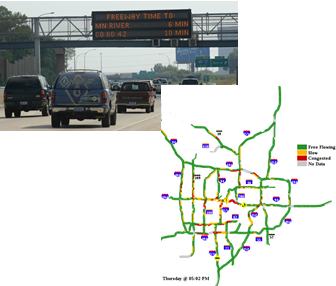 |
slide notes:
None
slide 6: Travel Time Messages - Actionability
Q71b. How often, if at all, do you take an ALTERNATE ROUTE because a travel time message on an overhead electronic message sign showed a longer time than your usual time for the trip?
- Among those drivers who make a route decision based on a travel time message, nearly 6 in 10 chose to take an alternate route at least some of the time.
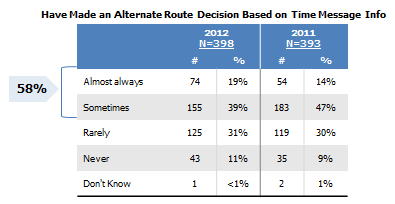
slide notes:
None
slide 7: Contracting options
- Traditional sub-contract to main project
- Stand alone for a single construction project
- Stand alone for multiple construction projects
slide notes:
Assume DOT doesn't purchase systems,
Really 4 ways of doing temp systems
4th is concept for us, haven't done it.
slide 8: Detection Trailer
|
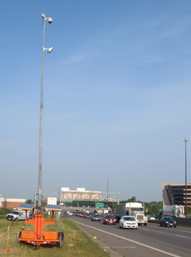 |
slide notes:
Equipment used is really consistent thru out the methods
And a controllable DMS
slide 9: Method #1 - Include in Main Construction
- Easy
- Fits Contracting Process
- Typically lump sum
slide notes:
It's Easy
It's what we do
Contract people like this method
Typically lump sum bid item
slide 10: Issues
- Low Priority
- Timing Startup time even more important with existing system integration
- Lack of communications about traffic switches
- Inadequate detection methods
- Increased detection spacing
- Probe data
- Cost
slide notes:
Picture is worth a thousand words
ITS is low priority for prime because of dollars
Timing is problematic at best
Need systems online at start of lane restrictions, Integration takes time
Deductions can't give drivers back the time they lost
Very inflexible, and limited control
Cost was really the straw
slide 11: Costs when Included in Main Project
- I-35E – From CR 96 to I-35
- 8 miles
- $250,000
- I-694 – From Hwy 61 to Hwy 5
- 7.5 miles
- $185,000
slide notes:
None
slide 12: Method #2 - Stand alone per Project
- Allows ITS Focus
- More Control for Contractor
- More Direct oversight by DOT
- Better Timeline
slide notes:
Prime Contractor is focused on ITS
Better control for both Contractor and DOT
Leads to better timeline, get started early
Which helps Integration
slide 13: Issues with Method 2
Still Can't address rapidly changing Construction Program
Susceptible to multiple Integration needs
Adds contract management needs
Cost
slide notes:
Lead time is sometimes more than the project
i.e. canned project on the shelf moved up
slide 14: Project example
|
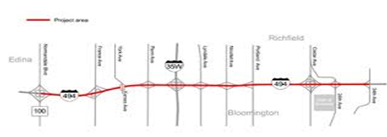 |
slide notes:
Our experience was very good with this project
Flexible,
Moved a camera to location to cover unanticipated loss.
Provided critical view of incident the following week.
slide 15: Another example
Another example
- I-94 Between Twin Cities and St. Cloud
- $187,100
- 24 miles of system
- Mix of Existing rural spaced Detection and DMS's
- 11 Temporary DMS
- 21 Temporary Detection trailers
slide notes:
Hasn't happened yet,
Very short duration,
Completed by mid summer
slide 16: Rural example
|
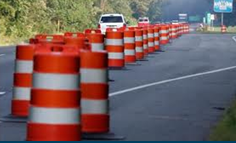 |
slide notes:
Left detection up to contractor
Significant issues with accuracy
MN/DOT and Contractor each held some responsibility
Perception tracking and survey results were interesting
slide 17: Method #3 – Stand alone for Multiple Projects
- All the benefits of stand alone ITS project
- Increased Flexibility
- Plus reduced
- Management costs
- Configuration and integration time
slide notes:
None
slide 18: Metro Wide Project - SP 8825-465
- Provide one prototype trailer.
- SP 0285-65 on I-694 from Hwy 252 to I-35W.
- Provide 16 trailers.
- SP 1982-161 on I-35E from I-35 south split to Cliff Rd.
- Provide 8 trailers.
- SP 2776-103 Hwy 169 River Bridge.
- Provide 18 trailers plus 3 PCMS.
- SP 7080-51, 7080-50 on I-35 from District Border to I-35 south split.
- Provide 30 trailers which includes 3 w/ cameras plus 3 PCMS.
- Actual bid price $569,141
slide notes:
Total Projected Cost - $640,750
Was plausibly $800,000 bid based on past rentals
slide 19: Looking Forward - Method 5
- Annual contract
- Most flexibility
- Provides options for smaller Maintenance projects
- Rapidly changing construction program
slide notes:
None
slide 20: Questions and Discussion
Contact Information
Ralph Adair
RTMC Integration and Systems Engineer
Ralph.adair@state.mn.us
651-234-7027
Jon Jackels
ITS Development Engineer
Jon.jackels@state.mn.us
651-234-7377
slide notes:
None
Return to List of Presentations